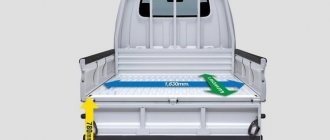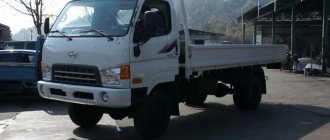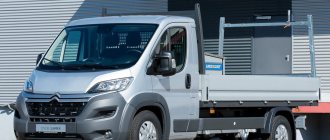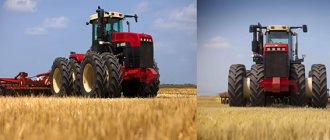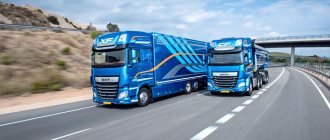The small-sized Hyundai Porter truck first appeared back in 1977; its successful design, load capacity of up to 1 ton, unpretentiousness and reliability became the reason for its worldwide popularity. Having survived the update, it began to be produced at a domestic plant, gaining its share of the commercial vehicle market. Among its advantages are noted:
- maneuverability;
- spacious comfortable cabin;
- reliable, soft and durable suspension;
- high-torque engine with long service life;
- unpretentiousness and rich equipment.
An important characteristic for commercial vehicles is its appetite. The Hyundai Porter has one of the most economical fuel consumption rates in its class, so it quickly returns the money invested in it.
Porter 1
The first version of the Hyundai Porter was equipped with a 2.5 diesel engine with 80 horsepower and a torque of 200 Nm, working with a five-speed manual gearbox. Its fuel consumption is:
- in the city 12.6 l;
- in mixed mode 10.3 l;
- on the highway 8 l.
Owner reviews
- Oleg, Chelyabinsk. I have my own small cargo transportation business, looking for an option for transporting goods around the city, I decided not to take the simple route of buying a Gazelle and purchased a Porter with an 80-horsepower engine. I am pleased with the car, which was created for the city, maneuverable, torquey, comfortable, and runs briskly in traffic when fully loaded. A nice bonus is fuel consumption - with a full load in the city no more than 14 liters.
- Vasily, Volgograd region. I am an apiary, and during my migration I have to transport bees for many kilometers. For this purpose, I purchased a Hyundai Porter with an 80 horsepower diesel engine. It’s a nice car, the soft and load-lifting suspension is well suited for transporting beehives, although the cabin could be more spacious. Maybe three Koreans will fit in it, but not healthy Russian men. Fuel consumption in a circle is 10 liters.
- Sergey, Saratov. The 2006 Proter is my work car. Among the shortcomings, I would like to note the inconvenience when getting in and out of the cabin. Otherwise, it’s a very good car – I’m especially pleased with its indestructibility; you don’t have to waste time on repairing the suspension or engine. The 80 horsepower engine is rather weak, but it pulls quite confidently, I drive mainly around the city and I consider the consumption of 13 liters per 100 km to be normal.
Briefly about the important
The history of the car
For the first time, Porter of the latest generation appeared before the consumer with the release of 2004, and after two more years it gained wide popularity among domestic motorists. The main advantages of the model were compactness, practicality, and economy. The gasoline consumption of the Hyundai Porter is not provided - these models work exclusively with diesel.
| Engine | Consumption (highway) | Consumption (city) | Consumption (mixed cycle) |
| 2.5D MT | 8 l/100 km | 12.6 l/100 km | 10.3 l/100 km |
| 2.5 CRDi MT | 9 l/100 km | 13.2 l/100 km | 11 l/100 km |
Average fuel consumption
The car is ideal for commercial purposes in the city, capable of quickly and efficiently transporting. It all depends on the mileage of the car, its load, and the ambient temperature.
Official fuel consumption figures
This is a truck, its technical characteristics do not provide for refueling with gasoline. Since it is presented in two modifications, the fuel consumption of the Hyndai Porter is different.
Consumption of auto type 2.5 D MT
:
- Fuel use in the city is 12.6 liters.
- The extra-urban cycle will take 8 liters.
- With a mixed road cycle and average speed, fuel consumption will be 10.3 liters.
Hyundai Porter II 2.5 CRDi MT modification car
:
- The consumption of a Hyundai Porter diesel in the urban cycle will be 13.2 liters.
- After 100 km of normal driving, Porter’s fuel consumption on the highway will be 9 liters.
- A mixed road will force you to spend 11 liters of diesel fuel.
Porter 2
The modified Porter received a more comfortable cabin, and a different diesel engine, which, with the same volume of 2.5, develops 123, 126 or 133 power at various boost levels. At the same time, its fuel consumption increased slightly:
- in city mode 13.2 l;
- on average 11.1 l;
- on the highway 9 l.
Feedback on consumption
- Peter, Astrakhan. After the appearance of the new model, I immediately purchased a Hyundai Porter with the most powerful engine of 133 horsepower, with an installed refrigerator, since I specialize in transporting fish. I think I was right; the machine is very comfortable and ideal for transporting such delicate cargo. With the equipment turned on, the consumption in the city does not exceed 15 liters, which completely suits me.
- Alexander, Moscow. I bought a Hyundai Porter because I think bongo-type trucks are the best option for a big city. This machine, with its high maneuverability, can move a two-room apartment in one trip. The 123 horsepower engine pulls decently and doesn’t let you get lost in traffic, but it consumes only 13 liters per hundred, which is simply a ridiculous figure for a truck.
- Vladimir, Novosibirsk. I bought a Porter for the occasion, with a 123 horsepower engine, since I do transportation myself. I would like to note the comfort in the cabin, the front suspension is very soft and does not require frequent repairs, the rear spring suspension is even more reliable, so operating costs are very low. Often you have to drive on the highway, consumption is exactly 10 liters per 100 km at a cruising speed of 100 km/h, that’s the magic of numbers.
Reviews from car owners
According to motorists, the average fuel consumption at full load in the city will be 10-11 liters.
Drivers also claim that such consumption for a truck is reasonable and economical. In winter, the actual fuel consumption of the Hyundai Porter will be 13 liters.
Hyndai Porter fuel consumption per 100 km outside the city will be no more than 10 liters. It is worth considering the speed of the car, since a traffic jam or fast driving forces you to use 0.5-1 liter more fuel.
In the characteristics of the engine of a car of this brand, the main aspect is the use of a diesel engine. The car has a practical purpose, because it was created for cargo transportation.
What is the average cost of gasoline for a Hyundai Porter? Not a single search engine will answer the consumer - it’s worth taking this into account. Similar questions are often asked in reviews. All sites indicate diesel fuel costs. It is this characteristic that makes the truck more economical compared to gasoline.
Video review
Hyundai Porter has the following dimensions:
- length – 4750 mm;
- width – 1690 mm;
- height – 1930 mm (with awning – 2420 mm);
- wheelbase – 2430 mm;
- ground clearance - 185 mm;
- front track – 1455 mm;
- rear track – 1380 mm.
Dimensions of the all-metal body:
- length – 2785 mm;
- width – 1600 mm;
- height – 355 mm.
Dimensions of the onboard platform with awning:
- length – 2785 mm;
- width – 1660 mm;
- height – 1700 mm.
The curb weight of the vehicle is 1660 kg, the load capacity is 950 kg (tilt version) and 1250 kg (flatbed version).
Fuel consumption rate established by the manufacturer - Design Features
| Hyundai Porter: 2, 1, owner reviews, technical specifications, how much it costs, payload, fuel consumption And vice versa, the higher the influence of competitive forces, the higher the likelihood that no company will be able to provide a high return on investment . If we compare the truck with the previous version, the Hyundai Porter 2 truck undoubtedly has a much more modern appearance, improved visibility and aerodynamics thanks to modified headlights, cab, side mirrors and doors. |
| Hyundai Porter 2: technical characteristics The internal layout is designed on the basis of a passenger car; easy landing, a wide range of seat adjustments, ergonomic arrangement of control mechanisms and easy-to-read instruments. Michael Porter believed that these market elements are the driving forces of market competition, which gave rise to the name of the model, Porter’s Five Forces of Competition model. |
Types of vans • To do this, after parking the car, do not immediately turn off the engine.
Main characteristics
Regardless of the chosen configuration and modification, all cars have rear-wheel drive. The truck has fairly compact dimensions:
- Length 4.76 m;
- Width 1.74 m;
- Height 1.96 m.
The ground clearance corresponds to the purpose of the car and is 15 cm.
Technical characteristics of the Hyundai Porter by weight demonstrate the following indicators:
- Curb weight is 1.91 tons;
- The total weight is 3.01 tons.
Its carrying capacity is about 1 ton.
The car is equipped with ventilated disc brakes at the front and drum brakes at the rear. The independent spring suspension at the front of the car is complemented by a dependent leaf spring at the rear. This ensures the endurance of the entire system, comfort for the driver and safety for the goods being transported.
Porter 2 has a convenient option for buyers - you can choose an option with a manual 6-speed gearbox or an automatic transmission equipped with 5 steps.
Hyundai Porter owner reviews
- Boris, Chelyabinsk. A good and reliable truck that has mostly positive reviews from my employees. Consumes 10-12 liters, no more. The 2.5 liter engine is diesel and requires high-quality diesel fuel. Otherwise, everything is fine, we service it in our own auto repair shop - it’s cheaper.
- Dmitry, Yaroslavl. Hyundai Porter is a truck for cramped cities and city traffic jams. The engine produces 80 horsepower and provides excellent dynamics and traction – thanks to its 2.5-liter volume. In the city you can achieve 11 l/100 km.
- Igor, Petropavlovsk. This truck is well adapted to harsh weather conditions and confidently overcomes all kinds of obstacles. A car with a 2.5-liter diesel engine and manual transmission consumes no more than 11-12 l/100 km.
- Nikolay, Petrozavodsk. I work as a carrier on a 2008 Hyundai Porter. A car with a two-door body, a van modification with a load capacity of 1000 kg. A car with a five-speed manual transmission and a 2.5-liter diesel engine with 80 horsepower. Despite the low power, the car is very high-torque and dynamic in the city, and this is noticeable at traffic lights. The car moves off confidently. Fuel consumption on average does not exceed 11 liters per 100 km.
- Mikhail, St. Petersburg. My transport company introduced me to the Hyundai Porter, a compact cargo van that allows you to quickly transport small loads. Load capacity at 1000 kg. The two-seater cabin is very spacious in all directions. In addition, I praise the car for its excellent visibility - you don’t even need a rear view camera. The car is equipped with a 2.5-liter diesel engine, which at 80 hp. With. consumes from 9 to 12 liters depending on the load.
- Sergey, Krasnodar region. A good car that will never let down a demanding customer, even on a long journey. Consumes no more than 12 liters, so it does not require large expenses. We have a batch of Hyundai Porter of 10 cars, all 2007, with an 80-horsepower diesel engine and manual transmission.
- Mikhail, Lipetsk. A comfortable and dynamic truck of compact dimensions with a high load capacity of up to 1000 kg. For this class this is an excellent indicator. The car is from 2009, with an 80 horsepower engine and a manual transmission. Fuel consumption 10-12 l.
- Oleg, Primorsky Krai. I drive a 2007 Hyundai Porter, a car with 70,000 miles on it – that’s not much for such a truck. The car drives comfortably even over rough terrain. And when loaded, the ride quality only improves. Fuel consumption is 11-12 l/100 km.
- Alexey, Stavropol region. I drove 80 thousand kilometers on the Porter. I'm used to the car. I used to drive a Ford Tourneo as a van, then they gave me a Porter with higher cargo capabilities. The compact truck is very nimble and dynamic in the city, consuming no more than 12 liters per 100 km. Motor 80 horsepower. The car is manufactured in 2009. I liked how the manual transmission works - it quickly clicks through the gears and ensures the full potential of the engine.
- Alexander, Ulyanovsk. I have a 2005 Hyundai Porter, mileage is 150 thousand kilometers. I drive a lot – in the city and on the highway, that’s why the mileage is so high. A car with an 80-horsepower diesel engine consumes only 10-11 liters, but is very demanding on fuel quality. There are no complaints about reliability.
- Rinat, Nizhny Novgorod region. The odometer of my Hyundai Porter shows 90 thousand km, it is a very strong and reliable truck, it is not afraid of our roads. The suspension does not break through at all. 2006 version, with a high-torque 80-horsepower diesel engine. Consumption is no more than 11-12 liters.
- Victor, Penza. I've driven 130 thousand km and the car is still running. Porter has high maintainability, and also has all the necessary options that will be needed on a long journey - for example, an internal combustion engine preheater, interior heater, heated seats, air conditioning, heater, etc. A car with an 80-horsepower diesel engine consumes 12 liters.
Hyundai Porter: fuel consumption per 100 km
The first generation of the Hyundai Porter went into production in early 1977. The model was called HD1000 and was offered in two versions (truck and minibus). It received the name Hyundai Porter later. It is noteworthy that the product was produced under a license purchased from Mitsubishi. The car was an almost complete copy of the Mitsubishi L300/Delica/Truck. Production of the first generation ended in 1981.
In November 1986, the Hyundai Porter II was introduced. The model was also not independent and was produced under license from a Japanese partner as a more budget “clone” of the Mitsubishi Delica (L300). Externally, the Korean product was almost completely identical to its “brother.” In 1993, double and extended cab versions appeared. The main engines were a 2.5-liter Mitsubishi 4D56 diesel engine and a 4-cylinder Cyclone D4BX engine. The car existed until 1995.
Cost of Hyundai Porter II
Front suspension - independent, torsion bar, wishbone, with hydraulic telescopic shock absorbers and anti-roll bar. Rear suspension - dependent, leaf spring, with hydraulic telescopic shock absorbers. Braking system - hydraulic dual-circuit with diagonally divided circuits, with a vacuum booster. The front wheel brakes are ventilated discs, the rear wheels are drum brakes. ABS is optionally available. The steering mechanism is of the rack-and-pinion type, the steering gear is equipped with power steering.
